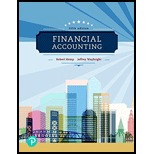
Financial Accounting (5th Edition) (What's New in Accounting)
5th Edition
ISBN: 9780134727790
Author: Robert Kemp, Jeffrey Waybright
Publisher: PEARSON
expand_more
expand_more
format_list_bulleted
Concept explainers
Textbook Question
Chapter 5, Problem 11SE
Inventory principles and terminology (Learning Objectives 1, 3, 4, & 5) 5-10 min.
Match the accounting terms on the right with the corresponding definitions on the left.
| _______ 1. Assigns the most recent inventory costs to ending inventory | a. Conservatism |
| _______ 2. Results in cost of goods sold that falls between what FIFO and LIFO produce, assuming rising prices | b. Full-disclosure |
| _______ 3. Principle that is the basis for using the lower-of-cost-or-market rule | c. LIFO |
| _______ 4. Principle that prevents a company from using a different inventory costing method each year | d. Average cost |
| _______ 5. Identifies exactly which inventory item was sold: usually used for unique inventory items | e. FIFO |
| _______ 6. Requires a company to report enough information for outsiders to make decisions | f. Consistency |
| _______ 7. Treats the most recent/newest purchases as the first units sold | g. Materiality |
| _______ 8. Principle that states significant items must conform to GAAP | h. Specific-identification |
Expert Solution & Answer
Want to see the full answer?
Check out a sample textbook solution
Students have asked these similar questions
What is value of retained earning
Accounts receivable:4750, Accounts payable:3050
Give me correct answer this general accounting question
Chapter 5 Solutions
Financial Accounting (5th Edition) (What's New in Accounting)
Ch. 5 - Prob. 1DQCh. 5 - How are the financial statements of a manufacturer...Ch. 5 - What is a cost-flow assumption? Why is a cost-flow...Ch. 5 - If a company had two units that cost 1 each in its...Ch. 5 - Prob. 5DQCh. 5 - Prob. 6DQCh. 5 - Prob. 7DQCh. 5 - Prob. 8DQCh. 5 - Prob. 9DQCh. 5 - Prob. 10DQ
Ch. 5 - During April, Bargain Hardware made sales of...Ch. 5 - Prob. 2SCCh. 5 - Prob. 3SCCh. 5 - Prob. 4SCCh. 5 - Prob. 5SCCh. 5 - Prob. 6SCCh. 5 - Prob. 7SCCh. 5 - Prob. 8SCCh. 5 - Prob. 9SCCh. 5 - Prob. 10SCCh. 5 - Prob. 11SCCh. 5 - Prob. 12SCCh. 5 - Prob. 1SECh. 5 - Prob. 2SECh. 5 - Prob. 3SECh. 5 - Prob. 4SECh. 5 - Prob. 5SECh. 5 - Prob. 6SECh. 5 - Prob. 7SECh. 5 - Prob. 8SECh. 5 - Lower-of-cost-or-market rule (Learning Objective...Ch. 5 - Prob. 10SECh. 5 - Inventory principles and terminology (Learning...Ch. 5 - Prob. 12SECh. 5 - Prob. 13SECh. 5 - Prob. 14SECh. 5 - Prob. 15SECh. 5 - Prob. 16AECh. 5 - Prob. 17AECh. 5 - Prob. 18AECh. 5 - Prob. 19AECh. 5 - Prob. 20AECh. 5 - Prob. 21AECh. 5 - Prob. 22AECh. 5 - Prob. 23AECh. 5 - Prob. 24AECh. 5 - Prob. 25AECh. 5 - Prob. 26AECh. 5 - Prob. 27AECh. 5 - FIFO (Learning Objective 2) 10-15 min. Tee Time,...Ch. 5 - LIFO (Learning Objective 2) 10-15 min. Refer to...Ch. 5 - Prob. 30BECh. 5 - Prob. 31BECh. 5 - Prob. 32BECh. 5 - Prob. 33BECh. 5 - Prob. 34BECh. 5 - Prob. 35BECh. 5 - Prob. 36BECh. 5 - Prob. 37BECh. 5 - Prob. 38BECh. 5 - Prob. 39BECh. 5 - Computing LIFO and journalizing inventory...Ch. 5 - Prob. 41APCh. 5 - FIFO, LIFO, and average cost (Learning Objectives...Ch. 5 - Prob. 43APCh. 5 - Prob. 44APCh. 5 - Prob. 45APCh. 5 - Estimating ending inventory (Learning Objective 7)...Ch. 5 - Prob. 47APCh. 5 - Prob. 48BPCh. 5 - Prob. 49BPCh. 5 - FIFO, LIFO, and average cost (Learning Objectives...Ch. 5 - Prob. 51BPCh. 5 - Prob. 52BPCh. 5 - Prob. 53BPCh. 5 - Prob. 54BPCh. 5 - Prob. 55BPCh. 5 - Continuing Exercise This exercise continues the...Ch. 5 - Prob. 1CPCh. 5 - Prob. 1CFSAPCh. 5 - Prob. 1EIACh. 5 - Prob. 2EIACh. 5 - Prob. 1FACh. 5 - Prob. 1IACh. 5 - Prob. 1SBACh. 5 - Prob. 1WCCh. 5 - Comprehensive Problem The Accounting Cycle for a...
Knowledge Booster
Learn more about
Need a deep-dive on the concept behind this application? Look no further. Learn more about this topic, accounting and related others by exploring similar questions and additional content below.Similar questions
- Hi experts please provide solution this general accounting questionarrow_forwardOn July 1, Archer Ltd. has retained earnings of $45,320. Revenues for July were $8,250. Expenses for July were $3,140. In July, the company paid out a total of $1,120 in dividends to its shareholders. What is the value of retained earnings on July 31?arrow_forwardWhich inventory costing method is prohibited under IFRS? a) FIFO b) Weighted average c) LIFO d) Specific identificationarrow_forward
- What is the value of the retained earning account at the end of the year?arrow_forwardA company sold office furniture costing $12,700 with accumulated depreciation of $10,150 for $2,200 cash. The entry to record the sale would include a gain or loss of what amount?arrow_forwardLattimer enterprises reported the following information for the year please answer the general accounting questionarrow_forward
arrow_back_ios
SEE MORE QUESTIONS
arrow_forward_ios
Recommended textbooks for you
- Century 21 Accounting Multicolumn JournalAccountingISBN:9781337679503Author:GilbertsonPublisher:Cengage
 Financial And Managerial AccountingAccountingISBN:9781337902663Author:WARREN, Carl S.Publisher:Cengage Learning,
Financial And Managerial AccountingAccountingISBN:9781337902663Author:WARREN, Carl S.Publisher:Cengage Learning,  Survey of Accounting (Accounting I)AccountingISBN:9781305961883Author:Carl WarrenPublisher:Cengage LearningPrinciples of Accounting Volume 1AccountingISBN:9781947172685Author:OpenStaxPublisher:OpenStax College
Survey of Accounting (Accounting I)AccountingISBN:9781305961883Author:Carl WarrenPublisher:Cengage LearningPrinciples of Accounting Volume 1AccountingISBN:9781947172685Author:OpenStaxPublisher:OpenStax College Cornerstones of Financial AccountingAccountingISBN:9781337690881Author:Jay Rich, Jeff JonesPublisher:Cengage Learning
Cornerstones of Financial AccountingAccountingISBN:9781337690881Author:Jay Rich, Jeff JonesPublisher:Cengage Learning

Century 21 Accounting Multicolumn Journal
Accounting
ISBN:9781337679503
Author:Gilbertson
Publisher:Cengage

Financial And Managerial Accounting
Accounting
ISBN:9781337902663
Author:WARREN, Carl S.
Publisher:Cengage Learning,


Survey of Accounting (Accounting I)
Accounting
ISBN:9781305961883
Author:Carl Warren
Publisher:Cengage Learning

Principles of Accounting Volume 1
Accounting
ISBN:9781947172685
Author:OpenStax
Publisher:OpenStax College

Cornerstones of Financial Accounting
Accounting
ISBN:9781337690881
Author:Jay Rich, Jeff Jones
Publisher:Cengage Learning
INVENTORY & COST OF GOODS SOLD; Author: Accounting Stuff;https://www.youtube.com/watch?v=OB6RDzqvNbk;License: Standard Youtube License